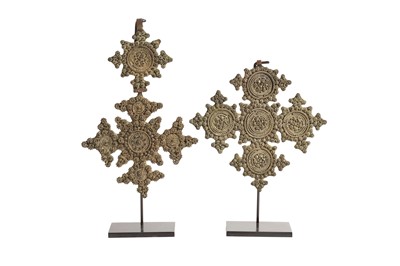29th Oct, 2020 13:00
Islamic & Indian Art
TWO HIGH TINNED COPPER COPTIC CROSSES PATONCE
Possibly Gondar, Ethiopia, 17th - 18th century
TWO HIGH TINNED COPPER COPTIC CROSSES PATONCE
Possibly Gondar, Ethiopia, 17th - 18th century
Comprising a Coptic cross patonce, with lobed, almost star-shaped ends, the core designed as a four-pointed star, the metal plaque enhanced with appliqued metal thread rosettes with stippled metal bubbles as their corolla, the central medallion with concentric beaded and scrolling plaited bands, the larger cross surmounted by a similar of smaller size, the back plain, mounted on a metal stand, 21cm x 13.5cm excluding the stand; and a similar Coptic cross, each end lobed and decorated with further protruding arrow-shaped terminals, in the centre of each terminal and core a circular medallion with concentric bands of plaited and appliqued beaded fretwork motifs, mounted on a metal stand, 15.5cm x 16cm excluding the stand.
Ethiopia, together with Armenia, was one of the first Eastern countries to embrace the Christian faith. There is evidence that Christianity thrived in the country even in the 1st century and for most of the country's history. Thus, crosses have played an important role in the decorative arts of Ethiopia, not only as a symbol of faith but also as auspicious talismans, embodying the very power of resurrection and life and reminding the believers of their union with God (monophysite's approach - tewahedo). Ethiopian crosses are almost invariably made from elaborate latticework and often bear particular features and characteristics according to the site of manufacture. The three main centres of metal cross productions in Ethiopia are Lalibela, Axum, and Gondar.
Sold for £500
Includes Buyer's Premium
Do you have an item similar to the item above? If so please click the link below to request a free online valuation through our website.




